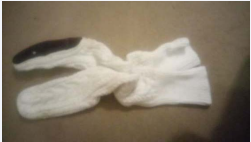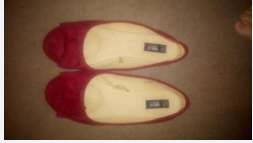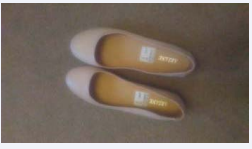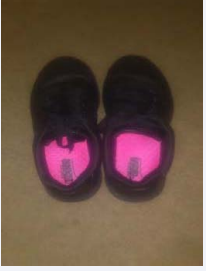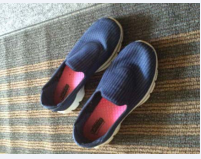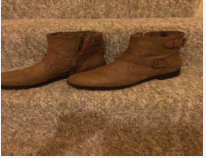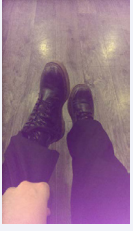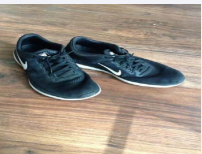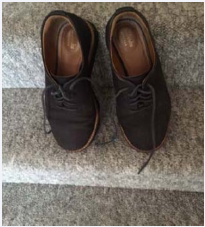Podolinguistics, Podopersona and Women
- 1. Illness and Disability, Great Ormond Street Hospital for Children, UK
- 2. Department of Podiatry, St Catherine’s Health Centre, UK
- 3. Department of Podiatry, Shuropody Nottingham, UK
- 4. Department of Podiatry, The Mind and Body Clinic, UK
Abstract
In the western world, shoes, sandals, trainers (the list goes on) are a part of our everyday dress choices; these choices shape our lives and how we exist day to day. We make conscious choices about the shoes we wear and these shoes we want to represent us. Previous literature has argued that this concept is called podolinguistics- defined as the ‘language’ of feet and shoes.
The aim of the study was to look at the daily shoe choices women make about the shoes they choose to put on their feet and why these choices are made. Women across the University of Brighton were invited to opt into a study utilising an electronic daily diary approach recording their daily shoes wearing choices over a period of 2 weeks.
10 female participants were recruited into the study via a poster/email campaign, looking for women who had an interest in shoes and were willing to share their thoughts. All participants engaged in the study; however the demands on undertaking such a time-consuming piece of daily research was evident to some. Ethical was granted from the University Of Brighton School Of Health Sciences Ethics Committee.
The diaries were analysed utilising interpretive phenomenological analysis (IPA) - which focuses on the ‘lived experiences’ of individuals and demands that only a few participants in a homogeneous sample are required.
The results generated four super ordinate themes; (i) External Factors Promotion Choice of Footwear (ii) Psychological Connection/Attachment with Shoes (iii) Psychological Reinforcement from Shoes (iv) Colour of Shoes. It should be noted that 14 subordinate themes were also generated.
Our findings highlighted that the participants had a personal connection with their shoes, which was significant in representing their podolinguistic identity. Women have an emotional connection with their footwear and their footwear choice, which we now define as ‘podopsychosamatics’ As a result, a woman’s podopersona (shoe personality/identity) is generated out of this complex relationship of shoe choice, colour, daily activities and a deeply personal psychosocial relationship.
Keywords
- Women
- Shoes
- Podolinguistics
- Podopersona
- Diaries
- Interpretive Phenomenological analysis
Citation
Morriss-Roberts C, Finnegan A, Casement C, Elliot C (2018) Podolinguistics, Podopersona and Women’s Everyday Shoes Choices: an Interpretive Phenomenological Diary Approach. JSM Foot Ankle 3(2): 1049
INTRODUCTION
Podlinguistics and the sociological study of feet and shoes is a relatively new phenomena [1,2]. Taking this into consideration, there is currently limited research available into the personal and emotional connection women have with their shoes, with many of the studies previously carried out being based purely by the involvement of observer’s and their views towards women and their footwear[3-12].
Emphasis is often placed on women who wear high-heeled shoes [13], and a real lack of evidence is noted regarding the real emotional or lived experiences of wearing certain shoes. Research methods chosen were often limited getting to the real essence of the ‘lived experiences’ wearing shoes [14-15].
3000 years ago shoes were designed to serve as a practical necessity and primarily to protect the foot [6]. For centuries, up until the Industrial Revolution, footwear remained to serve as a practical sense for the slaves and peasants, whereas the aristocracy wore shoes that were totally impractical but fashionable [15]. With the Industrial Revolution in the 18th and late 19th century came huge advances in science technology, agricultural and industrial production, industry and shipping; creating a new type of wealth [15].
As a result of this new type of wealth being created the ‘middle class’ materialised, and the shoes that were once for the privileged, suddenly became more accessible to greater numbers of the population [16]. As industry grew, by the turn of the 20th century more and more factories emerged producing more affordable and fashionable shoes, which subsequently became available to all classes [17]. Consequently, shoes are no longer seen as a practical necessity but as an object of desire [17].
Riello & McNeilargue that they more than a wrapping for our feet, they give us indications about someone’s character [18], and not only are we judged by the shoes we wear, society puts us into ‘society boxes’ according to the type, cost, brand and heel height of the shoes we wear [19].
It is claimed that the shoes we wear have an effect on the way we behave, indicating we have a personal emotional connection with our footwear which aids in creating our identity. This is identified as podolinguistics (the language of feet and shoes), with links to our emotions, personality and identity [1,11,20-24]. It is recognised that “Shoes are powerful; they have symbolic meaning which contributes to a woman’s vitality and her self-image [5] and that “every shoe tells a story [3], they are the best indicator of how people are feeling [3].
Shoes and shoe choices exist at the centre of current topical debates, including what shoes women shoe wear to work and the impact that inappropriate footwear can have on our health at work [24].
It should also be noted that this strong relationship that we have with our shoes, is not only a female issue, it exists for men also. Noted in the seminal developmental work on podolinguistics and sportsmen undertaken by Dr. Morriss-Roberts, Podiatrist, Researcher Fellow and Foot and Shoe Sociologist [1,2,11, 20,24,25].
The aim of the study was to consider the diaried lived shoe wearing experiences of women, their daily shoe wearing choices and the connection our participants had with their shoes.
MATERIALS AND METHODS
The study being carried out involved participants completing daily diaries and the researchers analysing the diaries using IPA [21]. In this context this is considered a new and novel approach.
Ethical approval
Approval was granted in July 2016, by the University of Brighton, School of Health Sciences Ethics Committee (SREGP).
Recruitment of participants
Posters were placed around the University of Brighton inviting women over 18 years of age with an interest in talking about their feet and shoes to opt in and contact us. The poster explained that the study lasted two weeks and required participants to keep an electronic diary and keep photos of their shoes. The only exclusion criteria were under women under 18 and ‘no interest in talking about shoes’.
Once recruited into the study, participants signed a consent form and were then sent all the participatory information via email. A diary template was also included as a guide; participants were to complete this template daily and to email their diary to the lead researcher. To ensure appropriate monitoring of the diaries a ‘Daily Record of Diary Entries’ (Table 1),
Table 1: Daily Record of Diary Entries
|
Pseudonym: |
Day 1 |
Day 2 |
Day 3 |
Day 4 |
Day 5 |
Day 6 |
Day 7 |
Day 8 |
Day 9 |
Day 10 |
Day 11 |
Day 12 |
Day 13 |
Day 14 |
No. Diaries Completed |
|
Nancy |
ü |
ü |
ü |
ü |
ü |
ü |
ü |
ü |
X |
ü |
ü |
ü |
ü |
ü |
13/14
|
|
Rose |
ü |
ü |
ü |
ü |
ü |
ü |
ü |
ü |
ü |
ü |
ü |
ü |
ü |
ü |
14/14
|
|
Kate |
ü |
ü |
ü |
ü |
ü |
ü |
ü |
ü |
ü |
ü |
ü |
ü |
ü |
ü |
14/14
|
|
Rhona |
ü |
ü |
ü |
ü |
ü |
ü |
ü |
ü |
ü |
ü |
ü |
ü |
ü |
ü |
14/14
|
|
Colleen |
ü |
ü |
X |
X |
X |
X |
X |
X |
X |
X |
X |
X |
X |
X |
2/14
|
|
Molly |
ü |
ü |
ü |
ü |
ü |
ü |
ü |
ü |
ü |
ü |
ü |
ü |
ü |
ü |
14/14
|
|
Alice |
ü |
ü |
ü |
ü |
ü |
ü |
ü |
ü |
ü |
ü |
ü |
ü |
X |
X |
12/14
|
|
Cathy |
ü |
ü |
ü |
ü |
ü |
ü |
X |
ü |
ü |
ü |
ü |
ü |
ü |
ü |
13/14
|
|
Julie |
ü |
ü |
ü |
ü |
ü |
ü |
ü |
ü |
ü |
ü |
ü |
ü |
ü |
ü |
14/14 |
|
Rosie |
ü |
ü |
ü |
ü |
ü |
ü |
ü |
ü |
ü |
ü |
ü |
ü |
ü |
ü |
14/14 |
For Daily Entries: ü= Diary Entry ReceivedX = Diary Entry Not Received
was drawn up which ensured the participant could be contacted by e-mail if they failed to e-mail any of their daily diaries.
For the purpose of writing the research, each of the female participants was given a ‘Participant Pseudonym’ (Table 2)
Table 2: Amount of time different or favourite shoes were worn
|
Participant Pseudonym |
Total number of Different shoes worn during study |
Number of times favourite shoes worn during this study. |
|
Nancy |
7 |
3 |
|
Rose |
6 |
8 |
|
Kate |
4 |
2 |
|
Rhona |
4 |
13 |
|
Colleen |
7 |
7 |
|
Molly |
3 |
7 |
|
Alice |
5 |
6 |
|
Cathy |
8 |
8 |
|
Donna |
3 |
3 |
|
Kim |
4 |
2 |
*Not all participants completed the study over 14 days and this has been taken into account when calculating the average number of daily shoe changes. Please consult ‘Daily Diaries Entry Record – Table 2’ for this information. A mean average has been used in this calculation.
- this typical practice within interpretive phenomenological research. These pseudonyms will be used throughout this paper for clarity of research process and situations to IPA.
When all participants had completed their diaries, the diaries were analyzed using interpretive phenomenological analysis (IPA) [21] (Table 3).
Table 3: Results Table of Themes
|
Superordinate Themes |
External Factors Promoting Choice of Footwear |
Psychological Connection/ Attachment with Shoes |
Psychological Reinforcement from Shoes |
Colour of Shoes |
|
Superordinate Themes |
Financial
|
Brand |
Confidence Booster |
Identity |
|
Impress Others
|
Emotion |
Positive Attitude/Enthusiasm |
Femininity |
|
|
Environment
|
Memories |
Acting as a body part |
Shoes before outfit
|
|
|
|
Activity
|
Stability |
ANALYSIS
IPA was used to understand the lived experiences of the female participants involved in the research and how each of the female participant’s make sense of their everyday shoe choice.
IPA favors using small numbers of participants [22], with diaries being chosen as the preferred method over interviews in this research project. Since diaries are open ended and flexible [23] and can be managed in the participants own time, it is more advantageous over analysis process,
IPA is a six-step process involving 1) Reading and re-reading; 2) Initial noting; 3) Transforming notes into emergent themes; 4) Searching for connections across emergent themes; 5) Moving onto the next case and 6) Looking for patterns across cases [1,20,21]. To ensure rigor, triangulation of the data was explored between all researchers to increase confidence of the final themes generated for the study [21,26].
RESULTS
To open this section, it should be noted that the results and discussion will be explored together for joined up thinking and clarity- it should be worth remembering this as you read this section. It should also be noted that participant’s pseudonyms will be used, to really embrace the lived personal experiences of the participants. This is common practice in excellent IPA research ad really connects the reader to your work and your participants messages [21,26].
10 participant’s diaries were obtained and analyzed using IPA as defined by Smith et al. [21], a table was drawn to show ‘Participant’s Total number of shoes worn and total number of times favorite shoes worn’ (Table 2).
A table of themes (Table 3) was created from the emergent themes. This led to the creation of four super ordinate themes and fourteen subordinate themes.
EXPLORATION OF THEMES AND DISCUSSION
1stSuperordinate Theme- ‘External Factors Promoting Choice of Footwear’ This theme considers why women chose to wear the shoes they do and what external factors influenced this decision.
In the first ‘Subordinate Theme’ the participants made reference to ‘financial’ factors.
It emerged many of the participants choose their shoes based on financial reasons. One female participant when purchasing new shoes based her choice on the shoes being able to match various outfits.
“I bought the boots because I can put them together with lots of outfits and dress them up or down”
(Rose Diary Transcript - Day 3)
With Rhona choosing to get the wear out of her shoes.
“I will wear them until they die”
(Rhona Diary Transcript - Day 1 & 8)
The statement made by Rose suggests she bought her boots as a necessity, which is quite the opposite of how Penderson describes shoes and they are no longer seen as a necessity, but as an object of desire [16]. Although Rose does not state she chose the shoes for financial reasons, using IPA the reader envisages her decision was made primarily based upon a financial decision and she could possibly be associating herself to women during the 2nd World War Period, when women needed individual ingenuity and creativity. Women from this period were encouraged to be creative and a ‘Make & Do Campaign’ was designed encouraging women to be creative but smart in their appearance [27].
Rhona appears to enjoy getting her money’s worth out of her shoes, and tends to buy shoes that she knows will last her for a considerable period of time; suggesting Rhona is cautious with her money. By looking at ‘Table 3’, we can see that one particular pair of Rhona’s shoes were worn 13 times during the 14-day period, which confirms this theory.
Kate is honest in her diary and admits to buying shoes to save herself money.
“I bought ‘junior’ trainers because I wanted to save money”
Kate Diary Transcript - Day 2)
However, using IPA, did Kate buy these ‘junior’ trainers because they were a bargain or did she want to look the part in the latest ‘Nike’ trainers? Did she suffer pain over pleasure and wear shoes that maybe were too small? One could perhaps compare this to a study carried out by Dilley, who suggests women often wear shoes too small for their feet and which cause them pain in their desperation to feel part of society [13].
In the ‘Second’ subordinate theme participants frequently made reference to ‘Impress Others’.
Many of the participants were prepared to endure pain from their footwear in their desperate attempt to gain approval from society; with many participants’s seeing their body image as boring and going to the extremes of pain and torture to not feel socially excluded, both mentally and physically. In effect, this could be comparable to that of the barbaric tradition of foot binding in ancient China, where woman endured pain in their desperation to be part of society [28] (Figure 1).
Figure 1: Slippers ‘reminder of surfing’
Colleen makes reference to her image and her shoes by saying:
“I was trying to portray a positive image”
(Colleen Diary Transcript – Day 3)
This suggests Colleen is conscious of how others see her; possibly showing her insecurity, which can also be confirmed by Colleen writing:
“one negative aspect of my trainers are they are not very unique”
(Colleen Diary Transcript – Day 5)
Did this ‘negative aspect’ arise because Colleen’s trainers were a little old; resulting in her insecurity, which may have possibly been brought on by media ‘body images’ as suggested by Boyce [15] (Figure 2).
Figure 2: Slip on Red Shoes ‘Feel more dressed up’
Colleen appears to have no confidence in herself and relies on the advice of others on what image to aim for, therefore showing her desire to impress others. In doing so, she avoids being isolated by society and escapes feelings of loneliness (alienation) [29]. This can be confirmed prior to an evening out when Colleen reports:
“Before wearing the shoes I was a bit apprehensive due to the fact that I was going out and would be standing all night so I was not sure if I wanted to wear them. However, I was convinced by a few friends to wear my heels as everyone was so I gave in”
(Colleen Diary Transcript – Day 7)
This suggests Colleen’s desire to impress others furthermore, by saying:
“My image or the way people probably saw me because of my footwear was of a party girl”
(Colleen Diary Transcript – Day 7)
Colleen knew she would be standing up all night, yet was prepared to endure this pain in order to gain acceptance from others. Was Colleen happy about this, and deep down, did she approve of her ‘party girl’ image for the sake of impressing her friends (Figure 3).
Figure 3: ‘Pink Shoes ‘Indoor Shoes’.
Was it a “party girl” she felt like, or was it more ‘prostitute like’? Did she feel she was being attracted to members of the opposite sex as a result of wearing high heels8 ; which made her feel awkward and as a consequence resulted in her feeling ‘prostitute like’ [10] (Figure 4).
Figure 4: Skechers for clinic ‘Very Comfortable’.
Molly, on the contrary does not look at anybody’s opinion in what shoes she wears by saying:
“Literally don’t give a flying fig for image when my feet are this comfy!!!”
(Molly Diary Transcript – Day 10)
Does this advocate Molly’s true feelings or is she swallowing her pride over image? Is she actually conscious of her image without actually realizing and wants to be part of society and blend in? This can be seen in her diary entry some days earlier:
“I’m a boots kind of woman; I’d probably be embarrassed to go to unique in heels or girly shoes”
(Molly Diary Transcript – Day 3)
The ‘Third Subordinate’ theme ‘environment’ draws us to the environmental factors that play a part in the participant’s choice of footwear. These factors play a huge part in the participant’s choice of footwear, with some of the participant’s learning from their mistakes when wearing a particular pair of shoes in the wrong setting:
“Weather was dry, which was why I could get away with wearing Skechers later on. They are definitely not waterproof”
(Cathy Diary Transcript – Day 3)
This suggests Cathy has previously worn her Skechers in the rain and definitely didn’t want to make the same mistake twice and end up with wet feet (Figure 5).
Figure 5: Skechers -Definitely not waterproof’.
This indicates Cathy likes to plan ahead and wear appropriate footwear for the weather, suggesting she is an attentive person, which she does admit to by saying:
“It is a windy and rainy day” - “I am more concerned with warmth and water proof today”
(Cathy Diary Transcript – Day 11)
Colleen on the other hand, is aware of the weather when choosing her footwear, and similar to Cathy, does like to plan ahead, but does so from a different angle:
“I don’t wear these boots in the rain as the suede properties of the boot do not take well to water (rain)”.
(Colleen Diary Transcript – Day 1)
Does this suggest that Colleen’s boots hold some sentimental value to her and she feels protective over them and doesn’t want to ruin them? This statement implies that her boots mean more to her than just a covering for her feet and unlike Cathy is not looking at her shoes providing ‘warmth and water proofness’ (Figure 6).
Figure 6: Brown Ankle Boots ‘Comfort’
Colleen on the other hand, similarly to Cathy appears to recognise her errors from her footwear. For instance, when talking about her slippers she states:
“The floors in the house are usually cold so to prevent discomfort and picking up a cold I do wear the slippers around the house”
(Colleen Diary Transcript – Day 2)
It would appear that Colleen’s slippers are acting as insulation or safeguard and a reminder to an episode in her childhood in which she appears to remember the episode meticulously.
The ‘Fourth Subordinate’ theme ‘Activity’ is the final subordinate theme in ‘External Factors Promoting Footwear’. This theme looks at the participant’s footwear and the appropriateness of the footwear based on the activity they are performing. One of the common features of this theme was the number of participants who chose their footwear based on their occupation. As well as being an essential part of a uniform, for some, comfort appears to be the most common factor when wearing shoes for their job.
One participant saying:
“I need to wear these shoes as part of my uniform in a clinical setting. They are also very comfortable”
(Alice Diary Transcript – Day 8)
This suggests Alice takes what she does in clinic seriously and wants to promote the right image to her patients; despite her having some minor setbacks particularly as she keeps on tripping up in her shoes (Figure 4).
“I tripped a few times again in these shoes but they are so comfortable and quite expensive so will continue to wear them”
(Alice Diary Transcript – Day 5)
Alice, despite tripping up in these shoes is determined to put up with them, as it would appear she hasn’t got the money to waste on shoes and she perhaps bought these shoes as an investment to show how conscientious she is about being in clinic. Is Alice concerned about the expense of the shoes or is she concerned with drawing attention to herself when she trips and being made a mockery of in public. Does she hate being the centre of attention and perhaps this signifies Alice wants to blend into the background.
Promoting the right image to patients by the wearing of appropriate footwear appears to be a recognizable theme, throughout, with Rhona stating:
“At unique we are all meant to wear wipes clean or washable clogs into clinic for cross infection control reasons”
(Rhona Diary Transcript – Day 5)
This suggests to the reader that Rhona is not a great believer in following rules, but does so when it is important to her; demonstrating Rhona has a rebellious attitude, but because she is passionate about what she does she seems to swallow her pride and understands the importance of wearing this particular type of shoe. She approves of her clogs and looks upon her footwear for clinic as being an important feature in creating the correct image to her patients by writing:
“I guess my clogs might conjure up an image of health professional about her work, that’s what I would think. They are a part of my uniform and so help with the illusion”
(Rhona Diary Transcript – Day 5)
It is not solely occupation under the subordinate theory ‘activity’ which promotes the participant’s decision when deciding on what footwear they wear, but also sports related, with participants writing about their wish to wear the correct footwear for the sport they partake in. This indicates that the participant(s) are passionate about what they do; helping to create a professional image, which in turn benefits the sport they are taking part in.
This can be understood from Kim’s statement, where she writes:
“I wear my basketball boots for training and matches, I think they look good”
(Kim Diary Transcript – Day 1)
Whether it be occupation or sports related, the pattern that emerges is that the shoes worn assist in creating a professional image, which possibly may enhance their performance; a similar study of which can be seen by Belk [30].
2nd Superordinate Theme - ‘Psychological Connection/ Attachment’
This theme explores the psychological personal connections/ attachments participants have with their shoes. Some of the participants are aware they do have a psychological attachment with their shoes and others are totally unaware.
The ‘first’ of the subordinate themes in this category is ‘brand’.
In the subordinate theme ‘brand’, several participants frequently made reference in their diary to the ‘brand’ of shoe they wore or made reference to their shoes being similar to a particular brand.
Nancy, frequently makes reference to:
“Green Van type trainers”
(Nancy Diary Transcript – Day 7 & 12).
And
“Black Dr Martin type shoes, called gillathes”
(Nancy Diary Transcript – Day 4)
One could say she was using the ‘brand name’ of a particular shoe for the benefit of the researcher, but yet, included a photograph of the shoe in question! Does this show Nancy’s desire to own this brand in order to gain social status, as suggested by Blanchard (Figure 7) [31].
Figure 7: Gillathes
Cathy on the contrary writes about brands in a different way. She frequently wears footwear from M&S and Clarks suggesting she likes comfort, reliability and quality. M&S pride themselves on quality and reliability and can be regarded as a traditional British culture in the same was as ‘The Beatles’ or ‘fish and chips” [32] (Figure 8,9).
Figure 8: Trainers.
Figure 9: ‘Navy Blue Clarks Shoes ‘Shoes are Comfortable’
Cathy advocates this by writing in her diary:
“Brown faux suede ankle boots with fur trim from M&S, went for comfort”
(Cathy Diary Transcript – Day 1)
“Navy blue nubuck lace up brogues from Clarks. These shoes are comfortable. Wore them all day – no need to change for dog walking”
(Cathy Diary Transcript – Day 2)
On a day when she wore her ‘Fly’ boots, Cathy did state:
“They are not comfortable to walk far in”
(Cathy Diary Transcript – Day 1)
Cathy claims they were uncomfortable because of the height of the heel:
“These boots have a higher heel than I normally wear & are not comfortable to walk far in”
(Cathy Diary Transcript – Day 1)
However, using IPA was the genuine reason for their discomfort because Cathy felt out of her ‘comfort zone’, as she was not wearing her reliable, trustworthy brand! Or, was it because of their ‘Victorian lace up’ style, with this style of boot conjuring up an idea of being kinky [33]. Did this style of boot act as an escape from reality, and perhaps Cathy felt uncomfortable with these erotic thoughts, and by wearing her dependable sensible M&S shoes was able to erase these thoughts.
In the ‘second’ of the subordinate themes ‘emotion’, using IPA we look at the emotional attachment the participants have with their shoes. It was established in this category that participants are not looking at their shoes as ‘objects’ but as ‘memory objects’, demonstrating they have an emotional connection with their shoes [34]. Alice writes about how the boots she wore made her feel close to a lost relative:
“These boots made me feel stable, grounded and fairly confident. My Mum always used to wear boots like this before she passed away. I feel I sometimes wear the same style my Mum used to, perhaps I feel closer to her this way”.
(Alice Diary Template – Day 1)
Despite Alice admitting:
“The shoes material is starting to look a bit worn”
(Alice Diary Template – Day 1)
Alice doesn’t ever want to part with these boots despite them being worn, as they are the same style her Mum used to wear. They are giving her the emotional support she needs to try and get through life without her Mum. Alice is possibly still grieving and by continuing to wear these particular boots she feels close to her. She doesn’t want to accept her Mum has gone and is reliving her Mum through the boots. As a result, a personal connection has been created with the boots, signifying an emotional attachment has been established [34].
In the ‘third’ subordinate theme ‘memories’, it was established that shoes hold memories to the participants from past events and they appeared to reminisce when wearing them. For example, Rose wrote:
“I do like these slippers because they remind me of surfing, that I used to do”
(Rose Diary Transcript – Day 2)
The slippers have memories attached to them for Rose and she appears to be missing the good old days (Figure 1). Is it the wavy knitting patterns on the slippers that may possibly be reminding her of the waves in the sea or did her take these slippers with her and wear them after surfing? Only Rose herself knows what memories these slippers hold. All the reader knows is that they remind her of surfing. What is evident is the number of times Rose wears these slippers in the 14-day diary period. Out of all the shoes worn by Rose she wears these most frequent. In fact, she wears these 8 times, suggesting the memories the slippers hold must be powerful.
The wellies owned by Rhona hold special memories. Rhona has owned them for a long time and describes how the wellies helped her when she was in a difficult situation:
“They are a bit worn now but I love my wellies. I’ve walked for miles in them. I wore them to clean up after I was flooded out in Lewes”
(Rhona Diary Transcript – Day 1)
The wellies helped her turn what must have been a catastrophic event into normality, signifying that the wellies are meaningful and she could never part with them. A psychological bond has been created between Rhona and her wellies and she would be devastated to lose them, which shows by her diary:
“When I broke my ankle for some reason I thought I would never be able to get them on again; I was heartbroken”
(Rhona Diary Transcript – Day 1)
The ‘fourth’ subordinate theme ‘stability’ explains how footwear gives the mental and physical stability required to get ‘through certain situations.
In Molly’s diary she writes:
“I’m really poorly so am spending the whole day wrapped up on the sofa reading, massive comfort factor in the slippers!!
(Molly Diary Transcript – Day 8)
What appears to be emerging is that Molly is clearly unwell and exhausted. She needs the emotional and physical assistance from her slippers to aid in her recovery. She is feeling lonely and sorry for herself and longing for the affection provided by her mother when she was sick as a child; signifying the slippers are providing this kind of mental and physical support her mother provided in the past [35]:
“I put them on for warmth and comfort”
(Molly Diary Transcript – Day 4)
3rd Superordinate Theme - ‘Psychological Reinforcement from Shoes’
Embodies the psychological support and reinforcement shoes provide throughout the day.
The ‘first’ subordinate theme in this category ‘confidence’ looks at how some of the participant’s shoes are either adding to their confidence or giving them confidence when premeditating a difficult day or event. What appears to be interesting is that the participants when planning their day and aware of difficulties that may lie ahead turn to their shoes to give them the added confidence they need.
Looking at Nancy who is going to a new gym class, she describes:
“slightly worried about a new gym class but confident because the shoes are comfortable, flat and up to the job of running and jumping around”
(Nancy Diary Transcript – Day 1)
Nancy admits she is worried about attending this new class (Figure 8). She is attending a ‘new class’, but is wearing ‘old shoes’. Nancy admits she is “worried” but the shoes make her feel “confident”. This indicates Nancy trusts the shoes, and knows they are appropriate for the class, but is unsure how she will perform in this class and knows her shoes won’t let her down; therefore, relying on her shoes to provide her with the confidence she requires. Unfortunately, Nancy did not mention in her diary how her class went, and one can only assume that it went well.
The ‘second’ subordinate theme ‘Positive Attitude/ Enthusiasm’ recognizes that the participants’ shoes assist them in creating a positive attitude and give them the enthusiasm they need for specific events. Nancy is a first aider for St John’s Ambulance and is volunteering at a fireworks event. As part of her uniform she needs to wear specific boots called ‘Giliathes’ (Figure 7).
She describes her feelings when wearing her boots as:
“Ready for anything”
(Nancy Diary Transcript – Day 4)
The boots provide Nancy with the enthusiasm she needs for what is going to be a fun but a hazardous event.
Nancy is mindful that she needs to work safely at the fireworks event and appreciates the material the shoes are constructed from are important:
“the shoes are water and fire proof and steel toe capped so we can work safely at the fireworks”
(Nancy Diary Transcript – Day 4)
Nancy is clearly concerned about her feet being damaged at the event and recognizes the boots will support her through the evening, consequently increasing her enthusiasm and providing her with a positive attitude to the evening ahead.
The ‘third’ subordinate theme ‘acting as a body part’ discusses the close relationship the participants have with their shoes. Some have become so close that nobody or anything could come between them. The bond has grown so strong; they are inseparable, comparable to a tendon being attached to a bone, or ‘attached at the hip’.
Rhona when wearing her clogs for clinic evidently has been through some good and bad times. Using IPA, she writes about her clogs as if they were a part of her body, but yet states she has no feelings for her clogs:
“I don’t feel much for my clogs although we have been through a lot together”
(Rhona Diary Transcript – Day 11)
The clogs appear to be supporting Rhona psychologically and physically in clinic, and although she has no feeling for them she would be devastated if they were absent or to break; similar to that of rupturing a tendon. One has no feelings for the tendon, but if there were an injury the immense pain both psychologically and physically would cause considerable anguish.
Rhona couldn’t even contemplate replacing her clogs with another pair even if they were an exact duplicate as they need to warrant their place:
"I haven’t attached any deeper feelings for them yet because they need to earn the right”.
(Rhona Diary Transcript - Day 14)
Rhona evidently does not give much thought to her shoes when they are new, and as events occur in her life, her shoes become associated with that event, therefore creating this ‘joined at the hip’ or ‘body part’ concept.
The general belief is that the participant’s shoes by acting as a ‘body part’ get them through situations together. Looking at Rose and the shoes she wore to run errands in, she writes:
“I only wore these shoes today as it was raining and I needed something practical and comfortable”
(Rose Diary Transcript – Day 1)
As with Rhona, Rose has no feelings for her shoes, but she knows they are the best shoes for the job and wears them frequently (8 times in the 14-day period – See Table 3), subsequently acting as a body part, they are a good team together, again like a bone being attached to a tendon.
4th Superordinate Theme- ‘Colour of Shoes’
It was recognized every single participant made reference to the colour of their shoes. With this being the most popular factor, one would presume that ‘colour’ appears to be the most important aspect to the wearer. It was also established that many of the participants when changing the colour of their shoes, appeared to change their inner feelings, with the colour of their shoes also having an effect on their body image.
The ‘first’ subordinate theme ‘Identity’ looks at the way in which the colour of the shoes we wear expresses our true character, due to the inner feelings we are experiencing. If we look at Alice, who frequently writes in her diary about her Mum passing away; in her 14-day diary period, she wore black shoes on 11 of the days, and only changes her shoes once a day. Using IPA does this signify she is still mourning the loss of her Mum with the colour ‘black’, acting as a security blanket or does it imply that Alice does not want to draw attention to her and likes hiding behind dark colors.
In fact, on one of the days when Alice chose to wear a pair of ‘light pink ballet pumps’ she anticipated she was staying indoors and only going outdoors to do household chores:
“I only put these shoes on to take my washing outside as my tumble dryer is located in an outhouse…………………….”
(Alice Diary Transcript – Day 9)
Rose on the other hand makes very limited reference to the colour of the shoes she wears throughout her diary entries (Figure 3). In fact, Rose only mentions the colour of her shoes twice which is in relation to the same pair of shoes. In total, for the 14-day diary period, Rose wore 6 different pairs of shoes and only mentions the colour for 1 of these pairs. Was this because the shoes were red, and she experienced feelings of lust and danger, or did she feel connected perhaps to a story or film [36]? What we are aware of is the colored stimulates physical and adrenalin rates. It raises blood pressure, the heart rate and respiration [37], and Rose was meeting a friend!
Where these red shoes expressing her true identity as she writes:
“Later in the afternoon I wore slippers again before changing into slip on red shoes to meet a friend, I wanted to be comfortable but slightly more dressed up than the daytime…………………… I then wore slippers in the evening………………………………………..”
(Rose Diary Transcript – Day 5)
What is interesting to note is that after wearing the ‘red shoes’, Rose changes into her slippers, the slippers she associates with ‘family’ and ‘home’, it was as though she needed the slippers to erase the character she had become when wearing those red shoes and the slippers brought home reality (Figure 2).
Across the ‘second’ subordinate theme ‘Femininity’, participants wrote how the colour of their shoes made them feel feminine. What appeared to emerge, especially in the case of Rose, is that the colour of her shoes transformed her from that of a boring old Mum to once again feel like a woman. The shoes are helping her feel sexy and not that boring frump of a mother she has become accustomed to, with her shoes helping to remind her she has curves and is a woman.
Nancy on the other hand feels her shoes provide her with a sweet girly type of image. During the day Nancy wears trainers to run in and go to university in and comes across as being a bit of a tomboy. However, when she gets home, she wants to leave that tomboy image behind and create an image of being feminine and girly and does this by wearing her:
“Girly, baby pink colour – Pink my little pony slippers, to keep my feet warm and clean, the baby pink colour makes me happy”
(Nancy Diary Template – Day 1)
Some may think it is the ‘my little pony’ logo that is creating this feeling of femininity, except Nancy clearly writes in her diary twice ‘baby pink colour’; the colour pink being associated with femininity, romance, intimacy and affectionate [38].
The ‘third’ subordinate theme in this category ‘outfit and colour of shoes’ examines the way the participants are conscious of their shoe colour matching their outfit (clothing). Using IPA is this an indication that women try to change their body image by colour co-coordinating, thereby subsequently visually improving it.
When Nancy goes to the gym she chooses to wear:
“Black and white trainers with her stretchy and comphy gym outfit, but it is all black and grey so it matches my shoes”
(Nancy Diary Transcript – Day 1)
By colour coordinating her shoes and outfit signals Nancy’s body image is important to her (Figure 8). Is she trying to improve her image by the use of coordinating because she is physically out of shape, particularly by her wearing stretchy clothing; and by colour coordinating she is hiding her figure. Does it show that Nancy finds her core body unattractive; with her shoes playing a role in deflecting from her core body image and which then increases her self-perceived attractiveness39.
Not only does Nancy choose the colour of her shoes to match her outfit but her makeup too.
“The outfit – black jeans, black doc martins, strippy top and dark lipstick”
(Nancy Diary Transcript – Day 6)
Nancy thinks she looks:
“a bit unintentionally gothic”
(Nancy Diary Transcript – Day 6)
Are the dark colors and lipstick she chose showing the dark, mysterious side to her, or is she trying to look elegant by coordinating her shoes and makeup, or is Nancy trying to colour coordinate her shoes, outfit and makeup in an attempt to make other women aware that she knows how to coordinate and is trying to make them envious of her [40].
CONCLUSION
Our results indicated and suggested that participants did have a personal connection with their shoes and which did aid in creating their identity, an indication that women do have an emotional involvement with their footwear and footwear choice.
The most popular theme that emerged throughout was the participant’s ‘colour of shoes’. This theme highlights how the choice of shoe colour is more significant than the colour of their outfit; with the colour of shoes they chose appearing to change their whole identity.
Many of the women in the study had to wear a specific shoe for their job or training. Although they appeared to disapprove of their regulatory shoes, many of the women wrote about how after a period time they had become emotionally attached to these shoes, with the period of time owned clearly being the element, and new shoes must earn their place to gain that status.
Generally, when we put on our shoes we do not think about the shoes we choose to wear, it is merely routine to us. Edmund Husserl describes this as ‘natural attitude’ [41]. By asking the women in the study to reflect on their feelings and their emotional connection proved difficult for some, as it was not part of their day to day routine, which can be seen through the ‘cutting and pasting’ throughout their diaries. Whether this was because they found it to be difficult to write about their feelings, busy or lazy was unclear. The diary template may have been too easy for some and if e-diaries were to be used again in this type of research it may be worthwhile reconsidering the non-use of the diary template and for the participants to write off the top of their heads.
Taking into consideration Husserl’s ‘natural attitude’ theory [41,42], it also became apparent from ‘Table (3)’, the highest number of average daily shoe changes was 2, with most of the women only wearing 1 pair of shoes per day. However, some women wore up to seven different types of shoes throughout the study and exploring strong reasons for the changes of shoes and the meanings to them. This draws connections to our changing emotions and identity throughout the day.
As a result of analysing the diaries, it became apparent that many of the women do have a personal attachment to their shoes, which demonstrates the powerful role that shoes can have in our lives. The have symbolic meanings which contribute to a woman’s vitality and herself image [30,43] confirm that every shoe does tells a story, they are the best indicator of how one is feeling [42]- highlighting strong links to podopersona, podopsychosomatics and podolinguistics. This work goes on to strengthen the theoretical concepts of podopersona (our personal identities with shoes), podopsychosomatics (our emotional connections with shoes) and podolinguistics (the language of our feet and shoes related to identity and what people read into our shoes).
We live in a world which is constantly changing which then changes the way in which we live our lives, and how we view ourselves and each other. Some of these changes can be personal to us, which then cause us to rethink our behaviour in society and which then changes our identity, particularly when this is related to the personal choice of shoes that we wear [43].
RECOMMENDATIONS FOR FUTURE RESEARCH
Reflecting upon the current research, future recommendations would be to undertake the same study again with men, so that we can compare the results and look for similarities and differences between men and women. Secondly, we would also recommend developing a photography protocol so that photos are consistent and are of excellent quality for publication.
ACKNOWLEDGEMENTS
We would like to acknowledge all the dedicated participants that took part in our study. We understood that this was a time consuming and challenging study to take part in every day. We would also like to thank the University of Brighton throughout the undertaking of the work.
REFERENCES
3. Newman C. Every shoe tells a story. Washington: National Geographic Society. 2006.
4. Waddell T. Female sexuality in advertising. St Kilda: The Australian Teachers of Media Inc. 2002.
5. Webster E. Red shoes: Linking fashion and myth. Textile. J Cloth Culture. 2009; 7: 164-177.
11. Morriss-Roberts C. What do men really think about women’s shoes and feet. Podiatry Now. 2014.
12. Halstead J. Time for the beck hams to take a lead on leg ulcers. Nursing Standard. 2010; 24: 26.
16. Pedersen S. Shoes: What every woman should know. Newton Abbot: David & Charles. 2005.
17. Hudson P. The industrial revolution. London: Edward Arnold. 1992.
18. Riello G, McNeil P. Shoes: A history from sandals to sneakers. Oxford: Berg. 2006.
22. Rossi, W. The Sex Life of the Foot and Shoe. Routledge and Keeger Paul, London. 1976.
23. Social Research Update. 1993.
26. Heale R, Forbes D. Understanding triangulation in research. Evidence - Based Nursing. 2013; 16: 98.
27. Clouting L. 8 Facts about Clothes Rationing in Britain During the Second World War. 2018.
29. Musto M. Revisiting Marx’s Concept of Alienation. Socialism and Democracy. 2010; 24: 79-101.
30. Belk RW. “Shoes and Self”. Advances in Consumer Research. 2003; 27-33.
31. Blanchard T. The shoe: Best foot forward, London, Carlton. 2000.
33. Steele V. Fetish: fashion, sex and power, Oxford University Press, Oxford. 1997.
36. Webster E. Red Shoes: Linking Fashion and Myth. Textile. 2009; 7: 164-177.
38. Day L. Psychology of colour. Early Years Educator. 2010; 12: 28-30.
41. Finlay L. Engaging Phenomenological Analysis. Qualitative Res Psychol. 2014; 11: 121-141.
